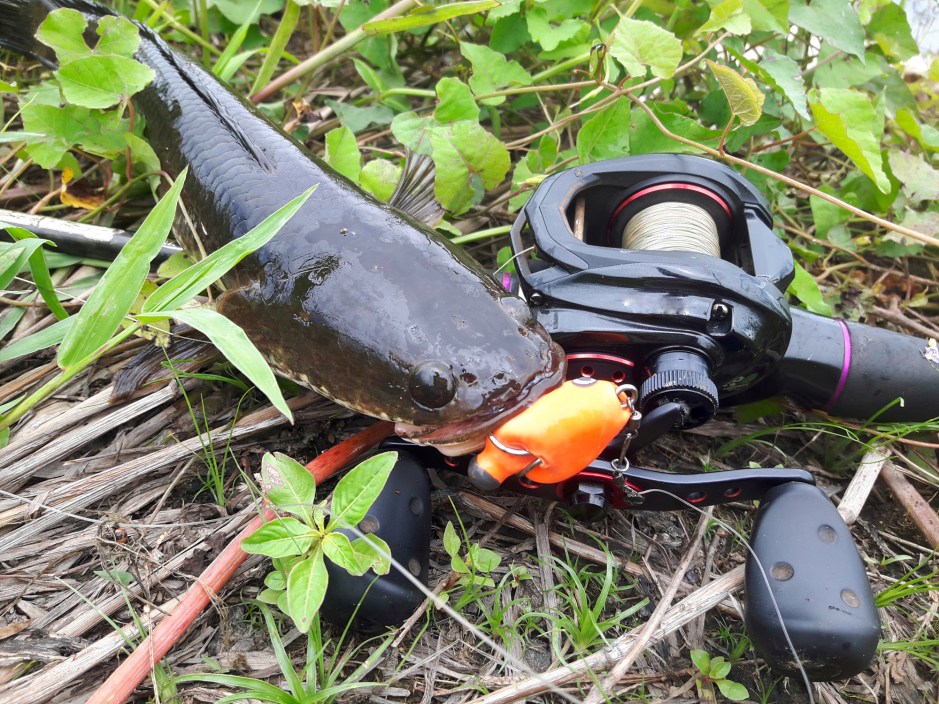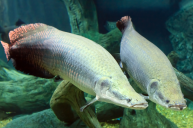Another invasive snakehead fish has been discovered in Missouri, sounding alarms for wildlife officials.
The "frankenfish" is an aggressive invasive fish species with a snake-like head that can jump out of the water and wiggle across land to new waterways. Not only can they breathe in both air and water, but snakeheads can also survive on land for up to four days, provided they are still wet. They can even migrate up to 400 meters (approximately a quarter of a mile) on wet land to other bodies of water by wriggling with their bodies and fins.
Missouri officials say they don't know yet what impact the invasive slitherers have on native fish populations. But we do know that as adults, snakeheads can be insatiable predators, so becoming established in our ecosystems could seriously disrupt the native food chain—and the species you like to fish.
The Latest Sighting
The snakehead was caught last month in a drainage pool at Duck Creek Conservation Area as state workers were catching bait for a youth jug-fishing clinic. This is the second snakehead fish discovered in Missouri; the first was located four years ago, the St. Louis Post-Dispatch reported. The first came from within the St. Francis River levee system in Dunklin County. This second fish was located in the same watershed as the first, about 70 miles north via the river.
"This fish has a wide temperature tolerance, can spawn multiple times in one year, and can survive in low-oxygenated waters by breathing air," said Dave Knuth, a fisheries management biologist with the Missouri Department of Conservation. "The impacts of this species on native fish populations are still to be determined, and it's something we will have to follow over time."
After workers discovered the snakehead in the Duck Creek Conservation Area, wildlife officials launched a search to locate any other potential snakehead lurking there. The officials said they spent two days looking for additional northern snakeheads in the 6,318-acre conservation area and neighboring 21,582-acre Mingo National Wildlife Refuge. No others were found, but it is likely that some do exist there.
Why Snakeheads Are a Problem
The snakehead is a top predatory fish that can cause substantial ecological damage because, in many areas to which they are not native, the absence of natural enemies gives them apex predator status over all native fish.
They reproduce rapidly, too. Each spawning-age female can release up to 15,000 eggs at once, and snakeheads can mate as often as five times a year once they reach maturity. This means that in just two years, a single female can release up to 150,000 eggs. Unlike other species, snakeheads often stay near their young well after each enormous hatch. That means more of them grow to adulthood to repeat the breeding cycle.
Snakeheads have been making a slow creep across the country. While somewhat reviled in the United States, the fish is considered a nutritious and flavorful food source in many parts of the world. It is a very common base for many Asian dishes.
The federal government banned the import and interstate transport of live northern snakeheads in 2002. Even so, populations in some parts of the country are firmly established, including the epicenter in Maryland's Chesapeake Bay.
What To Do If You See a Snakehead
The Missouri Department of Conservation recommends killing a snakehead by severing the head or gutting it, and reporting any sightings to the Southeast Regional Office. Officials have also requested that anglers not release the fish or throw it on the bank, as it could migrate back to the water or to a new water body.
READ MORE: 3 Lesser-Known Invasive Species You Can Start Worrying About




